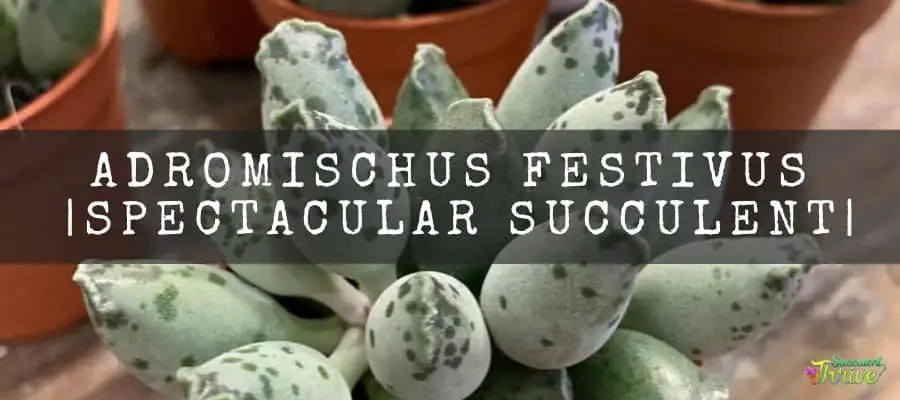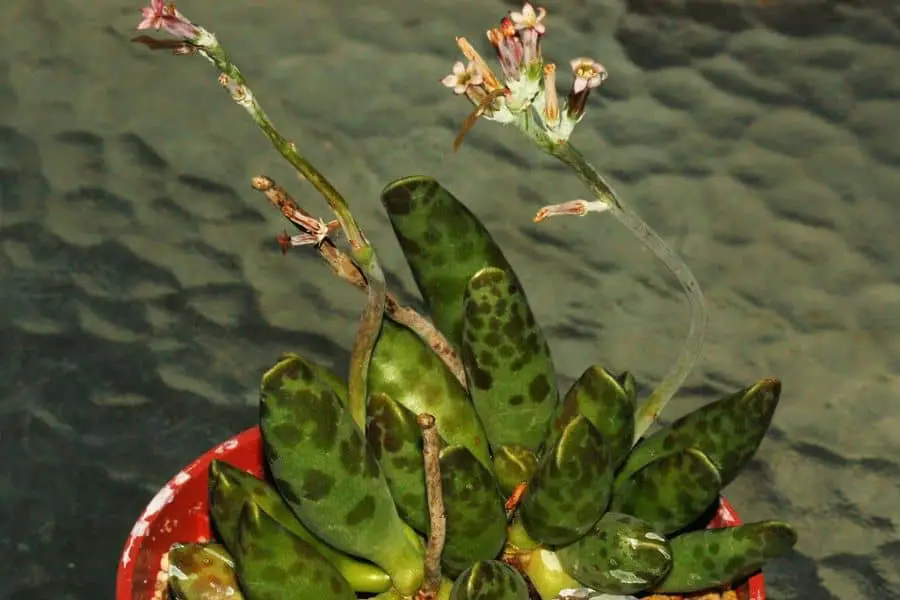If you are looking for a dwarf succulent, Adromischus festivus would be the one to try out. They are commonly known as Plover eggs. Adromischus festivus plants are hailing from South Africa and belong to the Crassulaceae family. You would commonly find these plants in high-altitude mountain areas in their native areas.
They are low-maintenance plants that can even thrive well with negligence. So, if you are someone busy and who doesn’t have much time to spare on gardening, Adromischus festivus would be quite handy here. So, in this article, I will be covering how to grow these plants from the beginning.

How do I identify Adromischus festivus?
The plants are low-growing dwarf plants. In terms of heights, Adromischus festivus would get as tall as 7 cm. further their leaves would be 2.5 – 5 cm in length. They would produce stems in groups. They are short and produce some sparse branching too. Once the Adromischus festivus get older, they would develop a caudex. Alternatively, they may produce a swollen area near the ground as well. Adromischus festivus would develop fibrous roots too.
The leaves of the Adromischus festivus would be chubby and glabrous or semi-cylindrical in shape. Further they would be mottled with dark green to red colors based on the sunlight exposure. In addition to these, Adromischus festivus would come up with flower blossoms in a white cream or pinkish violet-toned colors. One might think that it takes a dusty look too. They would usually form on a 25-60 cm inflorescence. Adromischus festivus develops a dry fruit as well.
One look care guide
| Botanical Name | Adromischus festivus |
| Common Name | Plover eggs |
| Plant Type | Succulent |
| Mature Size | 7.5 cm |
| Sun Exposure | Full sunlight to partial shade |
| Soil Type | Well draining |
| Soil pH | Neutral |
| Bloom Time | Spring and summer |
| Flower Color | White cream or pinkish violet toned colors |
| Hardiness Zones | 9b-11b : 3.9 degrees Celsius ( 25 degrees Fahrenheit) |
| Native Area | South Africa |
| Toxicity | Toxic |
How do you take care of the Adromischus festivus?
Size of the plant
Adromischus festivus would attain a maximum height of 7 cm when they grow to their best potential
Growth rate
Adromischus festivus grows at a slow pace.
Light Requirement
Adromischus festivus thrive well with morning direct sunlight and partial shade during the hottest hours of the day. Don’t grow them in full shade always as it would not help them to perform well. Adromischus festivus is tolerant of full sunlight in the morning as well as in the evening hours as well. Literally, they can withstand the full sunlight when it is not too intense. Adromischus festivus is somewhat vulnerable to sunburns. Hence, refrain from exposing them to such adverse conditions as it would create problematic conditions for the plants.
On the other hand, if you desire to cultivate them as indoor plants, you should locate them in the brightest sunniest spot in your home. So, a windowsill would be the ideal place to locate them. On the other hand, if the Adromischus festivus plants still starve for adequate sunlight, you can make use of grow lights to supplement the sunlight. Needless to mention, sunburns could take place if you had kept the plants in low light for some time and exposed them to full sunlight at once too. So, ensure that you don’t expose them to full sunlight abruptly if you had grown them indoors for some time.
Temperature and humidity
Adromischus festivus grow in hot and arid places when they grow in the wild. So, you need to ideally provide the same conditions they get in their natural habitat when you cultivate them too. A temperature range above 75 degrees Fahrenheit would be ideal for these plants. I encourage you to not expose these plants to temperatures that get dropped below 45 degrees Fahrenheit. It is noteworthy that if you expect the weather to get too colder, you need to protect the plants from shifting them indoors.
In terms of the right humidity aspect, you should always expose them to low humidity levels. Exposure to high humidity levels would not be ideal for these plants.
is it cold hardy?
Adromischus festivus is not cold hardy plants.
Growth Zone
Adromischus festivus preferred USDA hardiness zone would be 9b-11b) 3.9 degrees Celsius ( 25 degrees Fahrenheit).
Watering Requirement
Adromischus festivus would grow healthily and vigorously as long as you water them well. So you need to water them with so much care and patience. Make sure that you don’t supply them with excess water at any time. That is simply because excess water could turn out to be lethal to the plants and it could be the culprit for many other diseases too.
When you water, make sure that you water them thoroughly and then allow them to wither after that. if you end up watering them when they are moistened, it would make their soil soggy and damp. When it comes to watering sessions, I would say the best would be to water them once every two weeks during spring. Always try to keep the water from the plants when they are dormant. High humidity levels and excess watering in their dormancy would create trouble for them.
Soil Requirement Type / pH.
You could witness Adromischus festivus plants growing firmly if you grow them in an excellent draining soil mix. Ideally, you need to choose a cacti soil mix or a succulent soil mix for this purpose. That said, you may use an amended regular soil mix to grow these plants as well. You can be tactful in adding substances such as pumice to increase the draining in the soil mix.
Pot size Potting and Repotting
Adromischus festivus are slow-growing plants. As such you can repot them only every two years only. Periodic repotting is crucial for these plants as it would help the plants to grow freshly. In addition to that, it would allow you to have a thorough check-up on the plants as well. In terms of the right pots, you need to ideally proceed with a porous material pot that has one or two draining holes.

Where to Plant
Adromischus festivus have a strong demand in terms of sunlight. As such you need to ascertain whether the Adromischus festivus can absorb adequate sunlight in the chosen spot. When you grow them in a garden, it has to be a place that will allow the plants to fulfill their sunlight requirement and be protective from the intense sunlight as well.
If you live in USDA hardiness zone 9b-11b you can simply grow them outdoors. However, if you live in any other zone, the best is to grow them as indoor plants.
Fertilizers
Adromischus festivus don’t depend a lot on fertilizers. However, if you feed them lightly it would help them to grow better. The best fertilizer which you could use for this purpose would be a fertilizer that is specially made for the cactus and succulents. You may feed these plants once every two weeks when they are actively growing. Skip feeding the Adromischus festivus when they are in dormancy.
Flower
Adromischus festivus bloom with flowers in white cream or pinkish violet-toned colors. Those flowers would tend to take a tubular shape. You could witness them flowering during spring and summer. You can rarely spot them bearing flowers when you grow them indoors.
Dormancy
Adromischus festivus are winter dormant plants.
Toxicity
Adromischus festivus could be toxic if you ingest them. So, make sure that you keep them at a distance from the pets and from the kids too.
Common bugs and illnesses
Adromischus festivus are susceptible to pests’ attacks, especially from mealybugs, In addition to that, you can spot scales also invading these plants on and off too. Apart from that, weevils could also be troublesome for these plants. Last but not least, if you expose the plants to soggy and waterlogged conditions, it could contribute to root rot.
Special Care tips
Adromischus festivus may tend to shed their leaves at the gentlest touch. Hence ensure that you interact with the plants with so much care. Apart from that Adromischus festivus plants are low-maintenance plants and all you need to ensure is that you expose the plants to ample sunlight, water them well and lastly grow them in a fast draining soil mix.
Adromischus festivus benefits
Adromischus festivus would be excellent choices for container gardening as well as for outdoor gardening.
How to propagate Adromischus festivus.
The best is to use the leaf-cutting propagation method to propagate them. All you need to do is obtain the leaf cuttings from using sharp sterile tools. It is important that you use sterile tools unless they may result in contaminations in the specimens. Once you obtain the cuttings, place them in a warmer spot as it would help them to develop callous. Next place them upward in a gritty soil mix and water them when they are dry.
Conclusion
It would be fun growing these fantastic plants. Once you spot them flourishing you will feel accomplished. It may further tempt you to grow these plants more and more.
Read Next : Do Jade Plants Like To Be Root Bound? ( Not Exactly )
